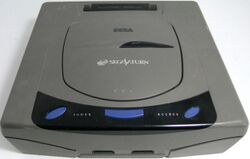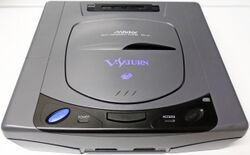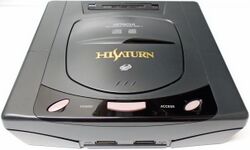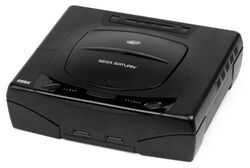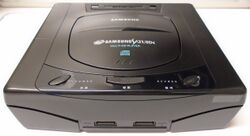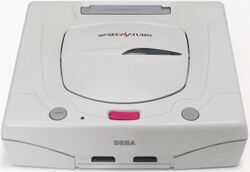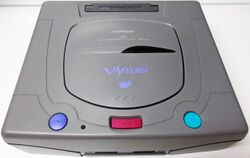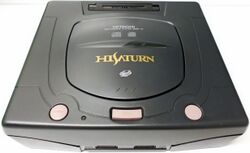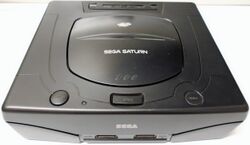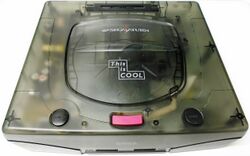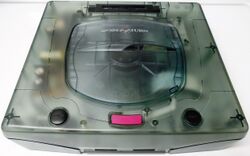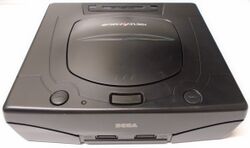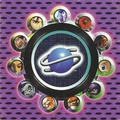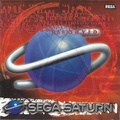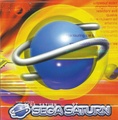Difference between revisions of "Sega Saturn"
From Sega Retro
| Line 223: | Line 223: | ||
As you can see, there are three different Sanyo drives, from two different type of drive families. Modchip guides seem to take them all under the same umbrella, and that's why one guide may not work with one of the Sanyo drives (as it was meant for the other type). | As you can see, there are three different Sanyo drives, from two different type of drive families. Modchip guides seem to take them all under the same umbrella, and that's why one guide may not work with one of the Sanyo drives (as it was meant for the other type). | ||
| + | |||
| + | Special Saturn units: | ||
| + | |||
| + | note: all production numbers are ESTIMATED FROM THE SERIAL NUMBERS. They may not be entirely accurate. | ||
| + | |||
| + | - "Skeleton" Saturns: exact same as the normal Japanese units, except for the shell and the boxing, and they came with transparent controllers as well. They had VA13 and VA15 motherboards inside. VA13 seems to have been in the HST-0020 Special Campaign Original machines, while the VA15 ones were in HST-0021 models. These were among the last Saturns ever produced. The HST-0020s were made in late 1997, and the VA15 ones in 1998. They were all made by Seiyo Denshi. Estimated production based on the serials seen: ~30,000 to ~40,000. | ||
| + | There is a rumor that made its way to Wikipedia stating that these units were made for the USA market, but this is false, no USA Skeleton machine exists. The only American skeleton unit was the Brazilian Tectoy model, which was most likely a rebranded Derby Stallion Skeleton unit. | ||
| + | |||
| + | - Derby Stallion: exact same as the normal Japanese units, except for the shell and the boxing. In contrast to the other Skeleton units, these had a lighter and greener transparent case and no "this is cool" logo. They were all VA15 boards, and the HST-0022 package they were sold as was the very last Saturn bundle Sega released. They were all made by Sanwa Denki in 1998, but released much later in 1999 to promote the Derby Stallion game software. Estimated production based on the serials seen: at least ~12,000, might be as much as ~30,000. | ||
| + | |||
| + | - JVC V-Saturn: exact same as the normal Japanese units, the only difference is the BIOS rom, the case color, and the brand. They used pretty much every type of motherboard and are quite common. Based on the serials, there are ~70,000 model 1 units and ~140,000 model 2 units produced, and they have been in production from the very start (November 1994) to the very end (July 1998). | ||
| + | |||
| + | - Hitachi Hi-Saturn: exact same as the normal Japanese units, the only difference is the BIOS rom, the case color, and the brand. They used VA0, VA1 and VA2 boards for the MMP-1, MMP-1-1 and MMP-1-2 units (model 1) and VA9 for MMP-11 units (model 2). They also had a Video CD card included, as they were meant to be multimedia units, sold for A/V enthusiasts. The case color was unique only for the top, the bottom of the case was a normal black one, like in USA and PAL machines. Produced: ~5,500 (MMP-1), ~2,000 (MMP-1-1), ~11,000 (MMP-1-2), ~10,000 (MMP-11). Note that due to the low production number, these estimates are not very accurate, they may have been thousands more units produced. | ||
| + | |||
| + | - Hitachi Hi-Saturn NAVI (MMP-1000NV): A specialized unit with an external power supply, karaoke controls (voice cancellation DSP and microphone inputs), GPS, optional LCD display, video input for optional TV Tuner, and lots of other things. They used a unique motherboard most likely based on VA1 or VA2/3 boards. The CD Drive is a huge cusotm board that houses all the extra audio functions. Optical pickup is unknown, presumed to be a Hitachi type. Has no RGB out, but it can be modded back in fairly easily. Produced from 1995 November to at least 1996 January, number of units produced is unknown, and hard to estimate as they are rarely seen. The highest serial on record of is 1416, so ~1,500 produced units seems plausible. A guesstimate given by nfggames is ~2,000 units produced. | ||
| + | |||
| + | - Samsung Saturn: a machine released in South Korea under the Samsung brand. There are a lot of rumors about what is inside these, but all units that have been seen opened up were all completely stock Japanese VA1 motherboards (171-7006C 837-11613-01), had everything intact, with only the region jumpers and the BIOS rom being different. The region is set to 2 for Korea, and the BIOS version states v1.02a and looks like the USA/PAL version rather than the Japanese one. Units produced: unknown, probably ~3,000-4,000, but there might have been a lot more. | ||
| + | |||
| + | - Asian / HK units: these were again normal Japanese units, with different boxing only, and a 220v power supply. These units all have their model numbers end in -07. Not much to say about these, their boxes were in English instead of Japanese. They are a nice option if you live in PAL land but want a 60hz machine without modding, as their 220v power supply makes voltage converters unnecessary. They had counterparts for almost every Japanese boxed release. Known motherboards are VA0, 1, 3, 5, 7, 13, and 15. The last few units came with Video CD cards preinstalled, and had a red "Video CD" label on the console and the boxing had unique yellow colors instead of white. | ||
| + | |||
| + | - Korean units: not to be confused with the Samsung Saturn. These were Sega branded model 2s, model number MK-80200A-08. There is very little info on these other than that they exist, were made in 1997, and use VA13 boards. | ||
| + | |||
| + | - Tectoy Sega Saturn: sold in Brazil by Tectoy, these units were essentially rebranded USA units at first (both model 1 and 2), then Japanese white units, and lastly Derby Stallion Skeleton Saturns. All these units had a few internal modifications: custom power supplies were added, all serial numbers were removed, the region was changed to region 4 for USA when necessary, and units were fitted to output PAL-M signal. This sometimes included changing the master clock to 14.302446 Mhz, but sometimes they only added a separate sub-board with an oscillator, and fed the clock input directly to the video encoder, leaving the default 14.318 Mhz master clock in place. | ||
| + | Since all serials were removed, it is impossible to guess how many of these were made. | ||
| + | |||
| + | - Sunseibu SGX: a unit that was apparently used as a hotel kiosk with a coin based timer system, and could house multiple game CDs inside which were selectable. There is not enough info on this, but the one internal screenshot seen has suggested that it used a VA SG or VA SD type board. | ||
| + | |||
| + | - SKC: short for Sega Karaoke Commander, this was a Denon/Columbia built dedicated Karaoke machine with multiple audio/video outputs, multiple microphone inputs, dedicated high quality mixers and DSPs, a modem, a SCSI hard drive, and connections for an optional CD Changer that could house ~50 discs, and for a coin counter. The unit connected to the internet and to download midi-esque song data + lyrics, and other updates such as latest news, ads, weather forecasts, etc. You could then select a song to play (even queue up multiple ones), and show off your karaoke skills for a few coins. It is assumed that the CD Changer could be filled with discs and then the system could double as a jukebox, but this is unknown. It could also play Saturn games, but with no battery backups and cart connectors, this function was limited - and it is unknown how it would've functioned with the coin input. Internally the machine uses mostly Denon boards, a Roland DSP board, and a Saturn board based on a VA0, but labelled as "Commander" instead, with its own BIOS. The machine has no RGB out, but has 4-6 Composite and S-video outputs, perhaps driving all of them at the same time. | ||
| + | There was a later revision called SKC-1000C which reduced the huge amount of boards inside. The main motherboard on that one was labelled "Commander C", and included the full Saturn hardware, the hard drive controller, and the ROM board (those were separate on the SKC-1000). | ||
===Technical specifications=== | ===Technical specifications=== | ||
Revision as of 23:17, 17 July 2017
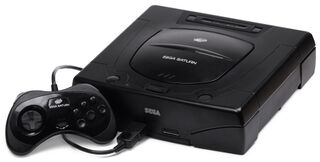
| |||||||||||||||||||||||||||||||||||||||||||||||||||||||
| Sega Saturn | |||||||||||||||||||||||||||||||||||||||||||||||||||||||
|---|---|---|---|---|---|---|---|---|---|---|---|---|---|---|---|---|---|---|---|---|---|---|---|---|---|---|---|---|---|---|---|---|---|---|---|---|---|---|---|---|---|---|---|---|---|---|---|---|---|---|---|---|---|---|---|
| Manufacturer: Sega | |||||||||||||||||||||||||||||||||||||||||||||||||||||||
| Variants: Sega Titan Video | |||||||||||||||||||||||||||||||||||||||||||||||||||||||
| Add-ons: Backup Memory, PriFun, Video CD Card, Extended RAM Cartridge, ROM Cartridge | |||||||||||||||||||||||||||||||||||||||||||||||||||||||
|
The Sega Saturn (セガサターン), is a video game console manufactured by Sega and was the successor to the Sega Mega Drive/Genesis (as opposed to add-ons such as the Sega 32X and Mega-CD). Initially released in 1994, the Saturn was a 32-bit compact disc-based system, and was a key player in what is now widely known as the fifth generation of video game consoles. The Saturn was first released on November 22, 1994 in Japan, May 11, 1995 in North America, and July 8, 1995 in Europe.
Depending on where you live, the Saturn could be described as either Sega's most successful console of all time (Japan) or one of their biggest commercial failures (North America). Despite being powerful for its time, its complex hardware and inability to meet rapidly evolving consumer expectations and demands put it in a distant third place in the Western world, but a combination of 2D sprite games, 3D arcade ports and strong marketing campaigns made the Saturn the most successful Sega console in Japan. Estimates for the total number of Saturns sold worldwide range from 9.5 million to 17 million.[9]
The Saturn's main competitors were Sony's PlayStation released just a week after the Saturn in Japan, and the Nintendo 64 from September 1996. Its arcade counterpart was the Sega Titan Video (ST-V) system. It was succeeded by the Sega Dreamcast in late 1998.
Contents
- 1 Hardware
- 2 History
- 3 Emulation
- 4 Games
- 5 Magazine articles
- 6 Promotional material
- 7 Artwork
- 8 Patents
- 9 External links
- 10 Footnotes
- 11 References
Hardware
The Sega Saturn is the successor to the Mega Drive, though as a video game system it is almost entirely different. It is a "32-bit" console, marketed in such a way that it appeared to be an evolution of the "16-bit" era of video gaming dominated by the Mega Drive and Super NES (which in turn succeeded the "8-bit" Master System and NES, respectively).
This description, however, was initially fabricated - Sega of Japan originally claimed the Saturn was a "64-bit" console[10] and some within Sega even chose to call it an "128-bit" machine,[11] a number arrived at by cumulating processors rather than simply picking the main CPU. Alternatively some areas of Sega simply went down the "multi-processor" route, refusing to get drawn into the perceived differences between 32-bit and 64-bit.[12] This was incidentally the last video game generation where these so-called "bit wars" were considered to matter.
The system uses CD-ROMs as its primary choice of media. Though it contains a cartridge slot, this is not used for games, but rather backup memory or RAM cartridges. The former was to extend the space for save games beyond that of the Saturn's internal memory, while the latter was used to augment the Saturn's limited memory and to avoid long CD load times.
The Saturn has two controller ports, and the standard Saturn controller builds on that seen in the six button Sega Mega Drive controller. It adds two shoulder buttons, first seen on the Super NES controller, bringing the amount of buttons up to nine. The 3D Control Pad, released later with NiGHTS into Dreams, would supply the console with an analogue stick and analogue shoulder buttons, the latter later being used in the Sega Dreamcast before being adopted by Nintendo and Microsoft for their GameCube and Xbox consoles, respectively.
The Sega Saturn hardware combined features from several Sega arcade systems.[13] It has a multi-processor system, like arcade machines. Its geometry engine consists of three DSP math processors, two inside both Hitachi SH-2 CPU and one inside the SCU, which were all intended to be programmed in parallel using complex assembly language, similar to how Sega programmed 3D arcade games at the time.
The VDP1 combined features from the Sega System 32 and the Sega Model series, with a quad polygon engine based on the Model 1, and texture mapping capability based on the Model 2 and System 32. The VDP1 is capable of drawing more polygons than the Model 1, but less than the Model 2. The Saturn was also influenced by the Sega Model 1's use of a separate graphics processor for the 2D backgrounds (based on the Sega System 24). The quad polygons are drawn with edge anti‑aliasing (for smoother edges), forward texture mapping (a form of perspective correction), bilinear approximation (reduces texture warping), and medium polygon accuracy (resulting in seamless polygons).[14]
The Saturn's VDP2 was based on Sega System 32 technology (an evolution of Super Scaler technology), used for both 2D backgrounds and 3D planes; the latter can be manipulated as polygon objects. The VDP2's tiled infinite plane engine uses tilemap compression and a form of scanline/tiled rendering to draw large, detailed, 3D texture-mapped infinite planes (for things such as grounds, seas, walls, ceilings, skies, etc.), with perspective correction and a virtually unlimited draw distance (and capable of effects such as transparency, parallax scrolling, reflective water surfaces, fog/misting,[15] fire, and heat haze), at a very high tile fillrate for its time.
The VDP2 draws 3D infinite planes as large as 4096×4096 pixels at 30 FPS, equivalent to a fillrate of over 500 MPixels/s, significantly larger than what any console or PC hardware were capable of with polygons at the time. It requires 1 million texture-mapped polygons/sec, with 500 pixels per polygon, to draw a texture-mapped 4096×4096 infinite plane at 30 FPS; the Dreamcast was the first home system capable of doing this with polygons, as it was the first home system that exceeded 500 MPixels/s polygon fillrate (using tiled rendering).
The Saturn was known for its difficult 3D development environment (especially for third-party developers), including its complex parallel processing hardware architecture, requiring familiarity with assembly language, lack of an operating system, and initial lack of C language support, useful development tools and graphics software libraries. Sega eventually provided DTS support for these features in late 1995. However, the C language development tools were not very well optimized for Saturn hardware, only tapping into a fraction of the Saturn's power, compared to assembly language which could tap into most of the Saturn's power. For example, the libraries did not use the SCU DSP, nor were they well-optimized for a multi-core CPU setup.[16] Some of the advanced techniques used by Sega's first-party AM studios did not become available until the introduction of SGL (Saturn Graphics Library).[17]
Only a handful of developers were able to squeeze most of the power out of the second SH-2 CPU, and even fewer utilized the SCU DSP, as its assembly code was more complex than the SH-2. Assembly language was often used by Japanese and British developers, but rarely used by American developers who preferred C language.[18] The VDP1 rendered quadrilateral polygons, which, despite being used by the most powerful gaming system at the time (Sega Model 2 arcade system), did not become industry standard for 3D graphics, compared to the more widely used triangle polygons.
The VDP2's tiled infinite plane engine, which could draw large 3D infinite planes with a much higher draw distance, texture details and fillrate than polygons at the time, was unfamiliar to most developers who relied on polygons to construct 3D planes. Sega's first-party 3D games often utilized both CPU, the DSP, and/or both VDP, but the hardware's complexity and difficult 3D development environment led to most third-party developers only utilizing a single CPU and the VDP1, just a portion of the Saturn's power, for 3D games. This was also partly due to the advanced techniques used by Sega's first-party studios being unavailable to third-party developers until the introduction of SGL.[17] While the VDP2 was under-utilized for 3D games, it was frequently used for 2D games, where the VDP1 draws sprites and the VDP2 draws scrolling backgrounds.
Models
- Main article: Sega Saturn consoles.
There are a variety of Sega Saturn models of different shapes and colours, as well as novelty units, such as the Game & Car Navi HiSaturn. Differences between systems are not as drastic as seen with the Sega Mega Drive - the same basic feature set and component designs were used throughout the console's lifespan in all regions.
HST-3200/HST-3210
First seen on launch day in Japan (1994-11-22), the HST-3200 (later revised and released as the HST-3210, although the differences aside from a BIOS update are not fully understood), commonly referred to as the "grey Saturn" (although during development it had a metallic finish), was the basis for all Sega Saturns released between the Japanese launch and early 1996. These Saturns use blue "oval" buttons, mounted to black plastic at the front of the unit, and have both "power" and "access" LEDs similar to the Sega Mega-CD.
The Saturn saw variants produced by Hitachi and Victor as the HiSaturn and V-Saturn respectively, though aside from altered BIOSes and aesthetics (and bundles/pricing) these do not deviate much from the Sega designs. Novelty value sees these models worth slightly more in pre-owned markets - fewer were produced than the Sega models, but compatibility rates are much the same.
Overseas versions are physically identical (save for region encoding), but use black plastic throughout.
HST-3220
Released in March 1996, the HST-3220 stands as the only significant change to the Saturn's design, although functionality wise, the only feature omitted is the "access" LED seen in previous models. Reportedly the change in colour scheme was made to appeal to younger and female demographics.[19]
These "white" Saturns likely cost less to produce (they were certainly sold for a lot less in Japan), but from a user perspective the change is largely negligible - the console is roughly the same size and has no problems running any Saturn software. White Saturns opt for grey "circle" power and reset buttons and a pink "open" button for lifting the lid.
It is rumoured, though not proven, that the HST-3220 has a faster disc reading time than its earlier counterparts, meaning quicker loading screens in games.
When brought overseas the console continued to be shipped only in black, although the North American and European models have different coloured buttons. In 1998 Sega started releasing special versions of these consoles with semi-transparent plastic under the "This is cool" brand - only 30,000 units were produced. Again aside from aesthetic differences the consoles are interchangeable.
Some of the Japanese colour designs were also brought to Brazil.
Revisions
Motherboards:
Note that the changes are all evolutional unless noted. If one revision, for example, integrates two ICs into one, all following ones have that too unless noted.
Board types used in Model 1: VA0 to 3
Board types used in Model 2: VA2 to 15
- VA0: Launch units, very first revision. CD Block is on a daughterboard, power supply mounted on top ("Type A"). Power led, access led, on/off and reset buttons, and the CD Tray open/close sensor are all separate. Uses ENR-007B drives (on some later units, ENR-007D). Very rarely they may have a Hitachi drive instead (JA00292).
- VA1: marked as "VA" on the motherboard, "VA1" on the controller board. Power supply is now bottom mounted ("Type B"). Every previous sub-board is now integrated to the motherboard, except the controller ports which are separated. This includes the CD Tray sensor which is now a very tall switch on the motherboards. Uses ENR-007D drives.
- VA2 & 3: Same form factor as VA1, but there are small changes to accompany the different CD Drive. The controller board is also a little different from VA1. VA2 is marked as VA SG, and VA3 is marked as VA SD. Type B power supply and ENR-011A drive. VA2 uses SG RAM for the main memory, VA3 uses SD RAM (hence their markings).
You'll notice that even revisions will all use SG RAM and the following odd one will use SD RAM, but the boards themselves are otherwise identical.
- VA4 & 5: Exactly the same as VA2 and 3, respectively, but in a model 2 case. The only difference is that a few components are removed (access led, memory reset button, resistor leading to both of them), since they are not used on model 2s anymore. Type B power supply, ENR-011A drive. Note that some model 2s are still marked as VA2 or 3 by the serial number, but they also have those components removed, perhaps some manufacturers failed to get the memo.
- VA6 to 9: Entirely new form factor, everything is in a single board from now on. Uses a new PLL chip (CY2292SC-45). Power supply has a different pinout ("Type C"). Uses ENR-013A drive. Some units may have a Sanyo 610-6185-30 drive instead. VA6 & 7 has the CD Block reduced to a single IC from the previous two, VA8 & 9 has them still separated. VA6 & 8 uses SG RAM, VA 7 & 9 uses SD RAM. VA9 seems to be using a much later design and is almost exclusive to PAL units, the only exception being the Hi-Saturn MMP-11. It also uses the old type PLL chip (315-5746, aka Hitachi HD49422).
- VA10 to 15: uses HQA-001A drive, sometimes rarely a Sanyo 610-6294-30 or a Sanyo 610-6473-30 instead. Sound block is now integrated to a single IC instead of two. Type C power supply. VA10 uses SG RAM, VA11 & 13 & 15 uses SD RAM. VA11 has a small extra daughter board to fix some design error. The function of that board is unknown. VA11+ boards have a different form factor DAC, VA10 uses the old one. VA12 and 14 were never produced. They would have been SG RAM counterparts to VA13 and 15. They may have been produced in extremely low quantities, so low that they haven't been spotted, but it is doubtful VA15 integrates the two SH-2 main cpus into a single IC.
Note: the integrated sound block has a bug in certain 68000 commands, this might be the same bug as the Genesis 3 suffers from as that one also has an integrated 68000 made by Yamaha. The result is that certain games are incompatible with these boards. The Japanese only releases of Space Harrier and Outrun are the only two that come to mind, and both have received second pressings that eliminate this bug and work in all machines equally. Metal Slug is rumored to be incompatible, but this appears to be false.
PAL Motherboards (only the main differences are listed, otherwise see above):
All PAL boards use different region & video output jumpers when compared to ntsc machines and use a 17.7344 Mhz master clock (NTSC units use 14.31818 Mhz). They also replace the c-sync output of the a/v out with a 9v connection, intended for SCART auto switching. On VA7+ boards, there is an extra power supply pin added to the entire machine just for that. C-sync is still there, just not wired into the a/v out, it can be restored with modding very easily (in case you are interested, the test point for c-sync is TP4 near the a/v out, on the bottom of the board).
- VA0 PAL - has extra jumpers to set the master clock divider (JP18 & 19), functional but unpopulated 50/60hz switch on the back (SW4).
- VA1 PAL - unpopulated 50/60hz switch on the back (SW4). There is a design snafu however, as it is still connected to the master clock divider select pin. Therefore the switch does not work on its own, you have to cut or raise+ground the PLL pin 1 for the switch to work.
- VA3 PAL - has extra jumpers to set the master clock divider (JP20 & 21), functional but unpopulated 50/60hz switch on the back (SW4).
- VA5 PAL - same as VA3 PAL.
- VA7 PAL - chronologically, this board was designed after VA9, likely to use up remaining stock of certain parts. Unlike NTSC boards, this still uses the old Hitachi PLL (315-5746), and its pin 1 is interconnected to the pal/ntsc and 50/60hz selection pins on the video encoder and the VDP2. So, for installing 50/60hz switches, you have to separate those accordingly. Has an extra fifth power supply pin for the a/v out (for SCART auto selection).
- VA9 - same notes apply as for VA7 PAL. This is an odd board in that it has no NTSC equivalent. Only the model 2 Hi-Saturn MMP-11 used VA9 boards, and they used the exact same boards as PAL machines, not counting the different jumper setup, master clock, power supply, etc.
- VA13 PAL - Has an extra fifth power supply pin for the a/v out (for SCART auto selection), but otherwise it seems to be identical to the NTSC boards.
It should be noted that no PAL board ever used SGRAM. The cause of this is unknown. Of course, the cause of using SGRAM in the first place is also unknown (and up to speculation - possible causes for both points include contractual obligations, shortage of one specific part, or a very good deal on SGRAM that made it worth to design two of each motherboards).
Power supplies:
Type A is for VA0 units, is mounted to the top, pinout is GND, GND, 3.3V, 5V, (empty pin), 9V. (5 pins total)
Type B is for VA 1 to 5 units, bottom mounted, pinout is GND, GND, 3.3V, 5V, 9V. (5 pins total)
Type C is for VA6+ units, bottom mounted, pinout is GND, GND, 5V, 5V (4 pins total). PAL units use a 5-pin variant of Type C power supplies, where the extra fifth pin is a 9V used exclusively in the a/v connector (for SCART auto switching). Later Asian units (that have a 220v power supply) most likely use that type of power supply too, with the 5th pin just not connected. In fact there are some USA machines that had a hole for the fifth pin but it was not connected to anything.
The moniker "Type A/B/C" is coined by the service manuals.
CD Drives:
20pin, VA0-1:
- JVC ENR-007B EMW10447-003E
- JVC ENR-007B EMW10447-004E
- JVC ENR-007D EMW10447-005E
- JVC ENR-007D EMW10447-006E
- Hitachi JA00292
These are all 20pin units. The Hitachi drive is rarely found in Japanese units, most commonly on early Hi-Saturns. They also seem to be exclusive to the SKC-1000 and SKC-1000C. There is a small difference in the microcontrollers used between ENR-007B and D.
21pin, VA 2-5:
- JVC ENR-011A EMW10589-002
- JVC ENR-011A EMW10589-003
These are the so-called 64pin drives. The -002 one seems to be used only in model 1s and the -003 only in model 2s, but it seems they are exchangeable.
21pin, VA6-9: - JVC ENR-013A EMW20035-002 610-6185-20 - Sanyo 610-6185-30 The JVC drive is most often referred to as the 32pin drive. The Sanyo drive may or may not come with an extra Trap Board, its function is unknown at this point.
21pin, VA10-15:
- JVC HQA-001A HQ100002-002 610-6294-20
- Sanyo 610-6294-30
- Sanyo 610-6473-30
Same as the above ones, but they all lack an oscillator and have a white border on the edges of the PCB. The Sanyo drive does not always comes with a trap board apparently.
Optical pickups used:
for EVERY JVC drive: Optima-6 (personally verified this for all drives)
for the Hitachi drive: HOP-6 (personally verified)
for Sanyo drives: SF-P101 is used in the 610-6185-30 (verified).
As you can see, there are three different Sanyo drives, from two different type of drive families. Modchip guides seem to take them all under the same umbrella, and that's why one guide may not work with one of the Sanyo drives (as it was meant for the other type).
Special Saturn units:
note: all production numbers are ESTIMATED FROM THE SERIAL NUMBERS. They may not be entirely accurate.
- "Skeleton" Saturns: exact same as the normal Japanese units, except for the shell and the boxing, and they came with transparent controllers as well. They had VA13 and VA15 motherboards inside. VA13 seems to have been in the HST-0020 Special Campaign Original machines, while the VA15 ones were in HST-0021 models. These were among the last Saturns ever produced. The HST-0020s were made in late 1997, and the VA15 ones in 1998. They were all made by Seiyo Denshi. Estimated production based on the serials seen: ~30,000 to ~40,000. There is a rumor that made its way to Wikipedia stating that these units were made for the USA market, but this is false, no USA Skeleton machine exists. The only American skeleton unit was the Brazilian Tectoy model, which was most likely a rebranded Derby Stallion Skeleton unit.
- Derby Stallion: exact same as the normal Japanese units, except for the shell and the boxing. In contrast to the other Skeleton units, these had a lighter and greener transparent case and no "this is cool" logo. They were all VA15 boards, and the HST-0022 package they were sold as was the very last Saturn bundle Sega released. They were all made by Sanwa Denki in 1998, but released much later in 1999 to promote the Derby Stallion game software. Estimated production based on the serials seen: at least ~12,000, might be as much as ~30,000.
- JVC V-Saturn: exact same as the normal Japanese units, the only difference is the BIOS rom, the case color, and the brand. They used pretty much every type of motherboard and are quite common. Based on the serials, there are ~70,000 model 1 units and ~140,000 model 2 units produced, and they have been in production from the very start (November 1994) to the very end (July 1998).
- Hitachi Hi-Saturn: exact same as the normal Japanese units, the only difference is the BIOS rom, the case color, and the brand. They used VA0, VA1 and VA2 boards for the MMP-1, MMP-1-1 and MMP-1-2 units (model 1) and VA9 for MMP-11 units (model 2). They also had a Video CD card included, as they were meant to be multimedia units, sold for A/V enthusiasts. The case color was unique only for the top, the bottom of the case was a normal black one, like in USA and PAL machines. Produced: ~5,500 (MMP-1), ~2,000 (MMP-1-1), ~11,000 (MMP-1-2), ~10,000 (MMP-11). Note that due to the low production number, these estimates are not very accurate, they may have been thousands more units produced.
- Hitachi Hi-Saturn NAVI (MMP-1000NV): A specialized unit with an external power supply, karaoke controls (voice cancellation DSP and microphone inputs), GPS, optional LCD display, video input for optional TV Tuner, and lots of other things. They used a unique motherboard most likely based on VA1 or VA2/3 boards. The CD Drive is a huge cusotm board that houses all the extra audio functions. Optical pickup is unknown, presumed to be a Hitachi type. Has no RGB out, but it can be modded back in fairly easily. Produced from 1995 November to at least 1996 January, number of units produced is unknown, and hard to estimate as they are rarely seen. The highest serial on record of is 1416, so ~1,500 produced units seems plausible. A guesstimate given by nfggames is ~2,000 units produced.
- Samsung Saturn: a machine released in South Korea under the Samsung brand. There are a lot of rumors about what is inside these, but all units that have been seen opened up were all completely stock Japanese VA1 motherboards (171-7006C 837-11613-01), had everything intact, with only the region jumpers and the BIOS rom being different. The region is set to 2 for Korea, and the BIOS version states v1.02a and looks like the USA/PAL version rather than the Japanese one. Units produced: unknown, probably ~3,000-4,000, but there might have been a lot more.
- Asian / HK units: these were again normal Japanese units, with different boxing only, and a 220v power supply. These units all have their model numbers end in -07. Not much to say about these, their boxes were in English instead of Japanese. They are a nice option if you live in PAL land but want a 60hz machine without modding, as their 220v power supply makes voltage converters unnecessary. They had counterparts for almost every Japanese boxed release. Known motherboards are VA0, 1, 3, 5, 7, 13, and 15. The last few units came with Video CD cards preinstalled, and had a red "Video CD" label on the console and the boxing had unique yellow colors instead of white.
- Korean units: not to be confused with the Samsung Saturn. These were Sega branded model 2s, model number MK-80200A-08. There is very little info on these other than that they exist, were made in 1997, and use VA13 boards.
- Tectoy Sega Saturn: sold in Brazil by Tectoy, these units were essentially rebranded USA units at first (both model 1 and 2), then Japanese white units, and lastly Derby Stallion Skeleton Saturns. All these units had a few internal modifications: custom power supplies were added, all serial numbers were removed, the region was changed to region 4 for USA when necessary, and units were fitted to output PAL-M signal. This sometimes included changing the master clock to 14.302446 Mhz, but sometimes they only added a separate sub-board with an oscillator, and fed the clock input directly to the video encoder, leaving the default 14.318 Mhz master clock in place. Since all serials were removed, it is impossible to guess how many of these were made.
- Sunseibu SGX: a unit that was apparently used as a hotel kiosk with a coin based timer system, and could house multiple game CDs inside which were selectable. There is not enough info on this, but the one internal screenshot seen has suggested that it used a VA SG or VA SD type board.
- SKC: short for Sega Karaoke Commander, this was a Denon/Columbia built dedicated Karaoke machine with multiple audio/video outputs, multiple microphone inputs, dedicated high quality mixers and DSPs, a modem, a SCSI hard drive, and connections for an optional CD Changer that could house ~50 discs, and for a coin counter. The unit connected to the internet and to download midi-esque song data + lyrics, and other updates such as latest news, ads, weather forecasts, etc. You could then select a song to play (even queue up multiple ones), and show off your karaoke skills for a few coins. It is assumed that the CD Changer could be filled with discs and then the system could double as a jukebox, but this is unknown. It could also play Saturn games, but with no battery backups and cart connectors, this function was limited - and it is unknown how it would've functioned with the coin input. Internally the machine uses mostly Denon boards, a Roland DSP board, and a Saturn board based on a VA0, but labelled as "Commander" instead, with its own BIOS. The machine has no RGB out, but has 4-6 Composite and S-video outputs, perhaps driving all of them at the same time. There was a later revision called SKC-1000C which reduced the huge amount of boards inside. The main motherboard on that one was labelled "Commander C", and included the full Saturn hardware, the hard drive controller, and the ROM board (those were separate on the SKC-1000).
Technical specifications
Processors
- Main CPU: 2× Hitachi SH-2 @ 28.63636 MHz[20][21][22]
- Configuration: Master/Slave
- 2x CPU cores: 32‑bit RISC instructions/registers, 74.454536 MIPS (37.227268 MIPS each, 1.3 MIPS per MHz),[23][24] up to 4 instructions/cycle (2 instructions/cycle per SH-2)[25]
- 2x DMA units: 2x DMAC (Direct Memory Access Controller),[26] parallel processing[27]
- 4x internal fixed‑point math processors:[28] 2x MULT multiplier DSP,[26][29][30] 2x DIVU division units,[26][29] parallel processing[31]
- Bus width: 64‑bit (2× 32‑bit) internal, 32‑bit external[34]
- Word length: 32-bit
- System coprocesor: Custom Saturn Control Unit (SCU), with DSP for geometry processing and DMA controller for system control[34][28][35]
- CD‑ROM CPU: Hitachi SH-1 32‑bit RISC processor @ 20 MHz (20 MIPS)[21] (controlling the CD‑ROM)
- Microcontroller: Hitachi HD404920[37] (4‑bit MCU) "System Manager & Peripheral Control" (SMPC) @ 4 MHz[28]
- Optional MPEG Video CD Card:[39][20]
- MPEG Video decoder: Sega P/N 315-5765 (Hitachi HD814101FE)
- MPEG Audio decoder: Hitachi HD814102F
Audio
- Sound processor: Yamaha SCSP (Saturn Custom Sound Processor) YMF292[40]
- Sound CPU: Motorola 68EC000 (16/32‑bit CISC) sound processor @ 11.29 MHz[34] (1.97575 MIPS[43])
- Bus width: 16‑bit internal, 16‑bit external
Video
- Sega/Hitachi VDP1 @ 28.63636 MHz: Handles sprite/texture and polygon drawing[44][37]
- Bus width: 48‑bit (3x 16‑bit)[28]
- Word length: 16-bit
- Sega/Yamaha VDP2 @ 28.63636 MHz: Backgrounds, scrolling, handles background, scroll and 3D rotation planes[45][37]
- Bus width: 32‑bit[28]
- Word length: 32-bit
- Sony CXA1645M RGB‑Composite Video Encoder[37]
Graphics
- Graphics pipeline:
- 3 DSP geometry processors: 2× SH-2 DSP, SCU DSP
- 2 VDP rendering processors: VDP1 for sprites/textures/polygons, VDP2 for planes/backgrounds/textures
- Video clock rate: 28.63636 MHz MHz (NTSC),[46][20] 28.4375 MHz (PAL)[46]
- NTSC dot clock: 7.15909 MHz (lo-res),[20] 14.31818 MHz (hi-res)
- PAL dot clock: 7.109375 MHz (lo-res), 14.21875 MHz (hi-res)
- Display resolutions: 320×224 to 704×480 (see Resolutions)[46][47]
- NTSC overscan resolution: 453×263 (lo-res),[20] 907×263 (hi-res)
- PAL overscan resolution: 454×313 (lo-res), 908×313 (hi-res)
- Refresh rate: 30–60 Hz (NTSC), 25–50 Hz (PAL)[48]
- Maximum frame rate: 60 FPS (NTSC), 50 FPS (PAL)
- Color depth: 15-bit RGB to 32‑bit RGBA (24‑bit color with 8‑bit alpha transparency)[42]
- Color palette: 16,777,216 (VDP2), 32,768 (VDP1)
- Colors on screen: 256 to 16,777,216 (VDP2), 256 to 32,768 (VDP1)
- VDP2 colors per background: 16 colors (4-bit) to 16,777,216 colors (24-bit)[49][50]
- VDP1 colors per sprite/polygon: 16 colors (4-bit) to 32,768 colors (15-bit)[51][52]
- CLUT: Virtually unlimited number of CLUTs[53]
- DSP geometry processing: 188 MIPS (million instructions per second)[fn 4]
- Geometry calculations: 114 MOPS fixed-point calculations[fn 9]
- Vertex transformations: 2,400,000 vertices/sec[fn 10]
- Polygon transformations: 1,800,000 polygons/sec[fn 11]
- T&L flat lighting: 800,000 polygons/sec[fn 12]
- T&L Gouraud lighting: 700,000 polygons/sec[fn 13]
- Transmission bus bandwidth: 143 MB/s
- Fillrate:
- Bitmap/Framebuffer fillrate: 26–28 MPixels/s (24-bit color), 82–85 MPixels/s (15-bit color), 143–150 MPixels/s (8-bit color), 250–264 MPixels/s (4-bit color)[fn 16]
- Tile fillrate: 280–570 MPixels/s[fn 17]
- Optional MPEG Video CD Card: 704×480 resolution, 30 frames/sec, 16‑bit audio with 44.1 kHz sampling,[66] up to 72 minutes on one CD[39]
SCU DSP
- SCU math coprocessor: Geometry DSP @ 14.31818 MHz, 32‑bit fixed‑point instructions[35][67][68]
- Parallel units: 32/48-bit ALU (arithmetic logic unit), 48/64‑bit Multiplier, 32-bit instruction decoder
- Buses:[67][69]
- Internal: 4 parallel buses, 32-bit per bus, 128-bit overall bus width, 3 buses at 14.31818 MHz, 1 bus at 28.63636 MHz
- External: 32-bit, 28.63636 MHz
- Cache RAM: 2 KB (1 KB data, 1 KB program)[70]
- Instructions: 6 parallel instructions/cycle (one instruction per unit/bus),[36] 85.90908 MIPS (6 MIPS/MHz)
- Fixed-point operations: 28.63636 MOPS (million operations per second), 2 MOPS/MHz (2 parallel operations/cycle)
- Capabilities: Matrix and vector calculations, 3D point transformations, lighting calculations, fixed-point calculations,[68] faster than SH-2,[71] can use DMA to directly fetch and store vertex data, floating-point operations, geometry transformations, voxel rendering acceleration, fast coordinate transformations, lighting computations,[72] transparency calculations[16]
- Notes: Can only be programmed with assembly language, more difficult to program than SH-2[68]
VDP1
- Main article: VDP1 (Saturn).
- VDP1 @ 28.63636 MHz: Handles sprite/texture and polygon drawing,[44] color calculation and shading,[28] geometry[53]
- Versions: Sega 315‑5883 (Hitachi HD64440) Video Display Processor 1 (VDP1),[37] Sega 315‑5689 VDP1[28]
- Adjustable video clock rate: 28.63636 MHz or 26.8465875 MHz (NTSC),[46][20] 28.4375 MHz or 26.8426 MHz (PAL)[46]
- Parallel data bus structure: 3 parallel data buses (dual framebuffers, texture cache), 48-bit data bus width (16-bit per bus),[73] 171.8184 MB/s bandwidth[fn 18]
- Parallel data bus cycles: 85.90908 million bus cycles/sec[fn 19]
- Color palette: 32,768 colors (15-bit RGB) to 16,777,216 (24-bit VDP2 CRAM palette, accessible by VDP1)[74]
- Features: Alpha blending, clipping, luminance,[52] shadows,[76] transparency[77] (3 alpha levels, or 32 alpha levels using VDP2 palette),[75] per-pixel transparency[78]
- Polygon capabilities: Texture mapping,[44] lighting,[79][80] shading, wire‑frame, flat shading, Gouraud shading,[78][28][80] 15-bit color Gouraud shading,[81] 15-bit colored lighting, quad polygons, edge anti‑aliasing,[82] forward texture mapping (form of perspective correction), bilinear approximation (reduces texture warping), medium polygon accuracy (seamless polygons)[14]
- Framebuffer capabilities: Double buffering, dual 256 KB framebuffers, rotation & scaling,[52] VDP1 framebuffer can be rotated as bitmap layer by VDP2[83]
- Framebuffer resolution: 512×256, 512×512, 1024×256[84]
- Overscan resolution: 1708×263 (NTSC), 1820×313 (PAL), 852×525 (31KC), 848×562 (HDTV)[47]
- Sprite/Texture capabilities: Rotation & scaling, flipping, distortion,[44][52] warping, vertical and horizontal line scrolling, virtually unlimited color lookup tables,[53][85] System 24/32 sprite rendering system[86]
- Sprite/Texture size: 8×1 to 504×255 texels[87]
- Colors per sprite/texture in Lo-Res: 16, 64, 128, 256, and 32,768[51]
- Colors per sprite/texture in Hi-Res: 16, 64, 128, and 256[88]
- Maximum texels per scanline: 1812 (NTSC),[46] 1820 (PAL)[47]
- Maximum sprites/textures per scanline: 226 (NTSC), 227 (PAL)
- Texture cache VRAM: 512 KB[89]
- Sprite/Polygon size: 32 bytes (flat shading),[65][90] 40 bytes (Gouraud shading),[91] 64–96 bytes (shadows),[78] 72–104 bytes (shadows, Gouraud shading)
- Texture size: 4 bytes (8×1 texels, 16 colors) to 251.02 KB (504×255 texels, 32,758 colors)[90]
- Maximum sprites per frame: 16,383 (virtually unlimited),[53] 13,106 (Gouraud shading), 5461–8191 (shadows)
- Maximum polygons per frame: 16,384 (flat shading), 16,383 (texture mapping), 13,107 (Gouraud shading), 13,106 (texture mapping, Gouraud shading), 8192 (shadows), 8191 (texture mapping, shadows), 7281 (texture mapping, shadows, Gouraud shading)
- Framebuffer fillrate: 28.63636 MPixels/s (16bpp),[fn 20] 35.6465 MPixels/s (8bpp)[fn 21]
- Texture fillrate: 19 MTexels/s (504×255 textures), 14 MTexels/s (10×10 textures), 12 MTexels/s (8×8 textures)[fn 24]
- Gouraud shading: 19 MTexels/s (504×255 textures), 9 MTexels/s (10×10 textures)[fn 25]
- Polygon rendering performance: Lighting[65][fn 26]
- Texture mapping performance: Lighting[81][97]
VDP2
- Main article: VDP2 (Saturn).
- VDP2 @ 57.27272 MHz: Handles background, scroll and 3D rotation planes[45]
- VDP2 cores: 4 parallel cores (17 units), 28.63636 MHz per core[102]
- Bus control
- H/V counter & timing generator
- Scroll picture block: 8 units (Normal picture coordinate calculation, Rotation picture coordinate calculation, Pattern name control, Window control, Character control, Line picture control, VRAM control, Dot data control)
- Video process: 7 units (Color offset & shadow, Output data control, Color computing control, Color RAM, Priority control, Color RAM control, Sprite control)
- Features: Transparency (32 levels of transparency, can also be applied to VDP1 polygons/sprites),[75] shadowing, 2 windows for special calculations,[50] matrix calculations,[103] multi-texturing,[104] bump mapping,[16] color gradients
- 3D infinite planes: Can be manipulated as large polygon objects,[105] with perspective transformation[106][107] and rotation. Can have curved surface and bumps,[108] and be used for grounds, walls, ceilings, seas, skies, etc.
- Visual effects: Water, fire, fog, heat haze, misting, reflective water surfaces[18]
- Rotation picture coordinate calculation: Geometry processing unit within Scroll picture block,[102] rotation and transformation of 3D planes,[106] manipulates 3D planes as very large polygons,[105] 24-bit fixed-point operations,[106] 28.63636 MOPS (million operations per second)
- Planes: 7 layers, 2–6 simultaneous layers (1–4 scrolling 2D backgrounds, 1–2 rotating 3D playfields, 1 back screen)[50][49][109]
- 2D scrolling backgrounds: Scrolling, parallax scrolling, single-axis 2D rotation[110]
- NBG0: 16–16,777,216 colors, tilemap (1024×1024 to 2048×2048) or bitmap (512×256 to 1024×512), column/row/line scrolling, scaling
- NBG1: 16–32,768 colors, tilemap (1024×1024 to 2048×2048) or bitmap (512×256 to 1024×512), column/row/line scrolling, scaling
- NBG2/NBG3: 16–256 colors, tilemap (1024×1024 to 2048×2048)
- 3D rotating playfields: Scrolling, scaling, dual-axis 3D rotation,[110] three-axis 3D rotation,[111] 3D infinite ground planes, perspective correct 3D rotation, can be manipulated as large polygon objects,[105] perspective transformation,[106][107] can have curved surface and bumps[108]
- RBG0: 16–16,777,216 colors, tilemap (2048×2048 to 4096×4096) or bitmap (512×256 to 512×512)
- RBG1: 16–16,777,216 colors, tilemap (2048×2048 to 4096×4096)
- Back screen: 1 plain background,[112] 1 to 240 colors (1 color/scanline)
- 2D scrolling backgrounds: Scrolling, parallax scrolling, single-axis 2D rotation[110]
- Tile capabilities: 8×8 and 16×16 tile sizes,[49] scroll plane up to 8192×8192 pixels,[113] rotating 3D infinite planes up to 4096×4096 pixels each,[109] tile compression, tile-based texture compression, tiled rendering, virtually unlimited draw distance
- Bitmap capabilities: Bitmap layers can be used as additional framebuffer[114] (with full transparency), displays VDP1 framebuffer as additional bitmap layer, can rotate VDP1 framebuffer[83]
- Color palette: 16,777,216 colors (24-bit), 32,768 colors (15-bit), 65,536 colors (15-bit with transparency)
- Bitmap fillrate:
- Tile fillrate: 251.65824–534.77376 MPixels/s[fn 37]
Resolutions
The Saturn supported the following display resolutions:[119]
Progressive
- 320×224 (Lo‑Res)
- 320×240 (Lo‑Res)
- 320×256 (Lo-Res, PAL)
- 352×224 (Lo‑Res)
- 352×240 (Lo‑Res)
- 352×256 (PAL)
- 640×224
- 640×240
- 640×256 (PAL)
- 704×224
- 704×240
- 704×256 (PAL)
Interlaced
- 320×448
- 320×512 (PAL)
- 320×480
- 352×448
- 320×480
- 352×512 (PAL)
- 640×448 (Hi‑Res)
- 640×480 (Hi‑Res)
- 640×512 (Hi‑Res, PAL)
- 704×448 (Hi‑Res)
- 704×480 (Hi‑Res)
- 704×512 (Hi‑Res, PAL)
Sound
- Main article: Saturn Custom Sound Processor.
- SCSP @ 22.58 MHz:[41][40]
- Audio channels: 32
- Sound formats: PCM, FM, MIDI, LFO
- PCM sampling: 16‑bit and 8‑bit audio depth, 44.1 kHz sampling sate (CD quality), up to 32 PCM channels
- FM synthesis: 1–4 operators per FM channel, up to 32 FM channels (1‑operator) or 8 FM channels (4‑operator)
- LFO waveforms: 4 waveform types (Sawtooth, rectangular, triangular, white noise), up to 32 LFO channels
- CD‑DA: 1 streaming CD‑DA channel (16‑bit PCM, 44.1 kHz) from CD
- Stereo audio output
Memory
- Total memory: 5–11 MB (5152 KB system, 39,408 bytes cache, 512–5120 KB cartridge, 1 MB card)
- System RAM: 4.53125 MB (4640 KB)[63][39]
- 2 MB Work RAM[fn 41]
- 1.5 MB VRAM[fn 44]
- 512 KB VDP1 texture cache VRAM[fn 45]
- 512 KB (2× 256 KB) VDP1 dual framebuffers[fn 46]
- 512 KB (512 KB) VDP2 background cache VRAM[fn 47] (tiled texture compression up to 17 MB)[fn 48]
- 512 KB Sound RAM[fn 49]
- 512 KB CD‑ROM sub‑system buffer data cache[fn 50]
- 32 KB battery backup SRAM[fn 51]
- System ROM: 512 KB BIOS[fn 52]
- Internal processor cache: 39,408 bytes (38.484375 KB)[34][28]
- Optional cartridge: 512 KB to 4.5 MB
- RAM cartridge: 512 KB to 4.5 MB
- Extended RAM Cartridge: 1 MB or 4 MB Work RAM[fn 53]
- Saturn Backup Memory: 512 KB battery backup
- Pro Action Replay: 512 KB battery backup
- Action Replay Plus: 4.5 MB
- 4 MB Work RAM[fn 54]
- 512 KB battery backup
- Saturn ROM Cartridge: 2 MB (The King of Fighters '95)
- RAM cartridge: 512 KB to 4.5 MB
- Optional MPEG Video CD Card: 1 MB (512 KB FPM RAM buffer, 512 KB MROM program)[39][20]
Configuration
System RAM buses, all connected through the SCU:[34][63][28]
- System bus[fn 41]
- SH2 (×2), SCU, SMPC <–> Work RAM,[fn 55] battery backup SRAM
- Video sub‑system buses[fn 56][44]
- Sound sub‑system bus — SCU, 68EC000, SCSP <‑> Sound RAM[fn 60]
- CD‑ROM sub‑system bus — SCU, SH1 <‑> CD‑ROM cache/buffer RAM[fn 60]
Bandwidth
Storage
Input/Output
- Main article: List of Sega Saturn accessories.
- Two 16‑bit bidirectional parallel I/O ports
- High-speed serial communications port (Both SH2 SCI channels and SCSP MIDI)
- Cartridge connector
- Internal expansion port for video decoder card
- Composite video/stereo (JP Part No: HSS-0106)
- NTSC/PAL RF (US Part No.: MK-80116, JP Part No.: HSS-0110)
- S-Video compatible (JP Part No.: HSS-0105)
- RGB compatible (JP Part No.: HSS-0109)
- EDTV compatible (optional)
Peripherals
- Main article: List of Sega Saturn accessories.
Power source
- AC110 volts; 60 Hz (US)
- AC240 volts; 50 Hz (EU)
- AC100 volts; 60 Hz (JP)
- AC240 volts; 60 Hz (AS)
- AC220 volts; 60 Hz (KR)
- 4 volt lithium battery to power non-volatile RAM and SMPC internal real-time clock
- Power Consumption: 25 W
Dimensions
US/European model:
- Width: 260 mm (10.2 in)
- Length: 230 mm (9.0 in)
- Height: 89 mm (3.2 in)
BIOS
| BIOS Version | Machine | Download |
|---|---|---|
| 1.00 | Sega Saturn (Japan) | 1.00 (Asian Saturn) (info) ("Sega Saturn BIOS (1.00) (J).zip" does not exist) |
| 1.00a | Sega Saturn (NA & EU) | 1.00a (NA & EU Saturn) (info) ("Sega Saturn BIOS (1.00a) (UE).zip" does not exist) |
| 1.003 | Sega Saturn Devkit (Japan) | 1.003 (Asian Devkit) (info) ("Sega Saturn BIOS (1.003) (J).zip" does not exist) |
| 1.01 | Sega Saturn (Japan), HiSaturn (Japan), V-Saturn (Japan) | 1.01 (Asian Saturn) (info) ("Sega Saturn BIOS (1.01) (J).zip" does not exist) |
| 1.01 (Asian HiSaturn) (info) ("HI-Saturn BIOS (1.01) (J).zip" does not exist) | ||
| 1.01 (Asian V-Saturn) (info) ("V-Saturn BIOS (1.01) (J).zip" does not exist) | ||
| 1.01a | Sega Saturn (NA & EU) | 1.01a (NA & EU Saturn) (info) ("Sega Saturn BIOS (1.01a) (UE).zip" does not exist) |
| 1.02 | HiSaturn (Japan) | 1.02 (JP HiSaturn) (info) ("Bios_Hi-Saturn_1.02_(J).rar" does not exist) |
| 1.03 | HiSaturn Navi (Japan) | 1.03 (JP HiSaturn Navi) (info) ("Bios_GameNavi_HiSaturn_1.03.rar" does not exist) |
Errata
- See VDP1 Errata
VDP1 transparency rendering quirk causes strips of pixels to be rewritten to framebuffer for 2-point (scaled) and 4-point (quadrangle) "sprites", applying the transparency effect multiple times. Rarely seen in commercial games (e.g. Robotica explosions), later titles implemented software transparency to correctly render transparent polygons (e.g. Smoke, shadows and a lot of particles in Loaded).
The VDP1 supports per-pixel transparency between different polygons/sprites in the VDP1 framebuffer, or between VDP1 and VDP2 layers, but not both at the same time, with the VDP2's transparency overriding the VDP1's transparency. There are several ways to overcome this issue. The most common method used by Saturn games is to fake transparency with dithering, using a mesh that gets blended by a television's Composite or S-Video cable. Another method is using a VDP2 bitmap layer as an additional transparent framebuffer, copying transparent assets from the VDP1 framebuffer to a VDP2 bitmap framebuffer layer (e.g. the transparent polygons in Burning Rangers). Another method is software transparency, programming the CPU with software code.
Technical comparison
- Main article: Sega Saturn/Hardware comparison.
History
- Main article: History of the Sega Saturn.
Emulation
The Saturn is notoriously hard to emulate due to its complex architecture (dual processors, etc.), but four notable emulators do exist:
- SSF is a highly compatible emulator, which is in continual development by a single developer.
- GiriGiri was initially based on an abandoned emulator by Sega themselves, and was considered the best until development ceased and SSF overtook it.
- Yabause is an open-source effort to create a Saturn emulator.
- Mednafen Sega Saturn is still in an experimental stage, but already highly compatible and can play games that don't work properly with SSF or Yabause.
Software that plays files in the Saturn Sound Format, which stores audio ripped from games, does so through emulation of the audio-related code only.
Games
- Main article: Sega Saturn games.
Magazine articles
- Main article: Sega Saturn/Magazine articles.
Promotional material
Print advertisements
|
|
|
also published in:
- Electronic Gaming Monthly (US) #77: "December 1995" (1995-xx-xx)[137]
|
|
also published in:
- CD Consoles (FR) #11: "Novembre 1995" (1995-xx-xx)[139]
|
|
|
|
also published in:
- SuperGamePower (BR) #19: "Outubro 1995" (1995-xx-xx)[141]
- Video Game (BR) #54: "Outubro 1995" (1995-xx-xx)[142]
- SPC Saturn Print Ad 2 KR.jpg
KR print advert
- Saturn Price Drop Print Ad KR.jpg
KR print advert
- KDS Saturn Print Ad KR 1.jpg
KR print advert
- KDS Saturn Print Ad KR 2.jpg
KR print advert
Pamphlets
Television advertisements
JP (launch)
US (1)
US (2)
US (Who?)
US (Who? 15 second variant)
UK (launch; long)
UK (launch; short)
Artwork
Patents
External links
- Dave's Sega Saturn Page - Famous fansite that was extremely popular during the Saturn's heyday (no longer updated).
Footnotes
- ↑ [MOPS (million operations per second) MOPS (million operations per second)]
- ↑ [1 operation per cycle[32] 1 operation per cycle[32]]
- ↑ [39 cycles per divide[33] 39 cycles per divide[33]]
- ↑ [74.454536 MIPS SH-2, 85.90908 MIPS SCU, 28.63636 MIPS VDP2 74.454536 MIPS SH-2, 85.90908 MIPS SCU, 28.63636 MIPS VDP2]
- ↑ [2x SH-2 MULT: 57.27272 MOPS[54]
2x SH-2 DIVU: 1.468531 MOPS (39 cycles per divide)[55]
SCU DSP: 28.63636 MOPS (add and multiply per cycle)
VDP2: 28.63636 MOPS 2x SH-2 MULT: 57.27272 MOPS[54]
2x SH-2 DIVU: 1.468531 MOPS (39 cycles per divide)[55]
SCU DSP: 28.63636 MOPS (add and multiply per cycle)
VDP2: 28.63636 MOPS] - ↑ [2x SH-2: 57,272,720 adds/sec (1 cycle per multiply)[54]
SCU DSP: 14,318,180 multiplies/sec (1 cycle per multiply)
VDP2: 14.31818 adds/sec 2x SH-2: 57,272,720 adds/sec (1 cycle per multiply)[54]
SCU DSP: 14,318,180 multiplies/sec (1 cycle per multiply)
VDP2: 14.31818 adds/sec] - ↑ [2x SH-2: 57,272,720 multiplies/sec (1 cycle per multiply)[56]
SCU DSP: 14,318,180 multiplies/sec (1 cycle per multiply)
VDP2: 14.31818 multiplies/sec 2x SH-2: 57,272,720 multiplies/sec (1 cycle per multiply)[56]
SCU DSP: 14,318,180 multiplies/sec (1 cycle per multiply)
VDP2: 14.31818 multiplies/sec] - ↑ [2x CPU: 3,579,545 divides/sec (16 cycles per 16-bit divide)[33]
2x DIVU: 1,468,531 divides/sec (39 cycles per divide)[55] 2x CPU: 3,579,545 divides/sec (16 cycles per 16-bit divide)[33]
2x DIVU: 1,468,531 divides/sec (39 cycles per divide)[55]] - ↑ [2x SH-2 MULT: 57.27272 MOPS (million operations per second)[54]
2x SH-2 DIVU: 1.468531 MOPS (39 cycles per divide)[55]
SCU DSP: 28.63636 MOPS (add and multiply per cycle)
VDP2: 28.63636 MOPS (only for VDP2's 3D planes) 2x SH-2 MULT: 57.27272 MOPS (million operations per second)[54]
2x SH-2 DIVU: 1.468531 MOPS (39 cycles per divide)[55]
SCU DSP: 28.63636 MOPS (add and multiply per cycle)
VDP2: 28.63636 MOPS (only for VDP2's 3D planes)] - ↑ [Transformation (21 adds/multiplies),[57] projection (4 adds/multiplies)[58] and perspective division (1 divide)[59] per vertex:
- 894,886 vertices/sec: 894,886 SCU DSP transformations (14 cycles per transform,[57] 2 cycles per projection), 894,886 SH-2 DIVU divisions (1 divide per vertex)
- 573,644 vertices/sec: 14,341,100 SH-2 MULT DSP transform/projection operations (25 cycles per vertex), 573,644 SH-2 DIVU divisions (1 divide per vertex)
- 1,011,294 vertices/sec: 41,463,054 SH-2 transform/projection/divide cycles (41 cycles per vertex)
- 894,886 vertices/sec: 894,886 SCU DSP transformations (14 cycles per transform,[57] 2 cycles per projection), 894,886 SH-2 DIVU divisions (1 divide per vertex)
- 573,644 vertices/sec: 14,341,100 SH-2 MULT DSP transform/projection operations (25 cycles per vertex), 573,644 SH-2 DIVU divisions (1 divide per vertex)
- 1,011,294 vertices/sec: 41,463,054 SH-2 transform/projection/divide cycles (41 cycles per vertex)]
- ↑ [8 vertices per cube (6 quad polygons)[60] 8 vertices per cube (6 quad polygons)[60]]
- ↑ [8 transformations (168 adds/multiplies), 6 surface normals (72 multiplies, 36 adds),[61] 6 light sources (72 adds/multiplies),[62] 8 projections (32 adds/multiplies) and 8 perspective divisions (24 divides)[58] per cube with 8 vertices and 6 quad polygons:
- 52,640 cubes/sec: 52,640 SCU DSP cubes (112 transform cycles, 72 surface normal cycles, 72 light source cycles,[62] 16 projection cycles), 1,263,360 SH-2 DIVU divisions (24 divides per cube)
- 8548 cubes/sec: 2,940,512 SH-2 MULT DSP transform/projection operations (347 cycles per cube), 205,152 SH-2 DIVU divisions (24 divides per cube)
- 72,614 cubes/sec: 52,862,992 SH-2 transform/projection/divide cycles (728 cycles per cube)
- 52,640 cubes/sec: 52,640 SCU DSP cubes (112 transform cycles, 72 surface normal cycles, 72 light source cycles,[62] 16 projection cycles), 1,263,360 SH-2 DIVU divisions (24 divides per cube)
- 8548 cubes/sec: 2,940,512 SH-2 MULT DSP transform/projection operations (347 cycles per cube), 205,152 SH-2 DIVU divisions (24 divides per cube)
- 72,614 cubes/sec: 52,862,992 SH-2 transform/projection/divide cycles (728 cycles per cube)]
- ↑ [8 transformations (168 adds/multiplies), 8 surface normals (96 multiplies, 48 adds), 8 light sources (96 adds/multiplies), 8 projections (32 adds/multiplies) and 8 perspective divisions (24 divides) per cube with 8 vertices and 6 quad polygons:
- 44,744 cubes/sec: 44,744 SCU DSP cubes (112 transform cycles, 96 surface normal cycles, 96 light source cycles, 16 projection cycles), 1,073,856 SH-2 DIVU divisions (24 divides per cube)
- 16,444 cubes/sec: 7,235,360 SH-2 MULT DSP transform/projection operations (440 cycles per cube), 394,675 SH-2 DIVU divisions (8 divides per cube)
- 58,942 cubes/sec: 48,568,208 SH-2 transform/projection/divide cycles (824 cycles per cube)
- 44,744 cubes/sec: 44,744 SCU DSP cubes (112 transform cycles, 96 surface normal cycles, 96 light source cycles, 16 projection cycles), 1,073,856 SH-2 DIVU divisions (24 divides per cube)
- 16,444 cubes/sec: 7,235,360 SH-2 MULT DSP transform/projection operations (440 cycles per cube), 394,675 SH-2 DIVU divisions (8 divides per cube)
- 58,942 cubes/sec: 48,568,208 SH-2 transform/projection/divide cycles (824 cycles per cube)]
- ↑ [Multiplexed (57.27272 MB/s VDP1, 57.27272 MB/s VDP2), 16-bit per VDP, 28.63636 MHz[63][64]
- Maximum VDP1 polygon transfer: 1,789,772 polygons/sec (57.272704 MB/s, 32 bytes per polygon)[65]
- Maximum VDP1 polygon transfer: 1,789,772 polygons/sec (57.272704 MB/s, 32 bytes per polygon)[65]]
- ↑ [8-bit, 28.63636 MHz[64] 8-bit, 28.63636 MHz[64]]
- ↑ VDP1: 28.63636 MPixels/s (15-bit color), 35.6465 MPixels/s (8-bit color)
VDP2: 26.8426–28.63636 MPixels/s (24-bit color), 53.6852–57.27272 MPixels/s (15-bit color), 107.3704–114.54544 MPixels/s (8-bit color), 214.7408–229.09088 MPixels/s (4-bit color) - ↑ [VDP1: 28.63636–35.6465 MPixels/s
VDP2: 251.65824–534.77376 MPixels/s VDP1: 28.63636–35.6465 MPixels/s
VDP2: 251.65824–534.77376 MPixels/s] - ↑ [57.27272 MB/s per bus 57.27272 MB/s per bus]
- ↑ [28.63636 MHz texture cache, 28.63636 MHz draw/render framebuffer, 28.63636 MHz display/erase framebuffer[48] 28.63636 MHz texture cache, 28.63636 MHz draw/render framebuffer, 28.63636 MHz display/erase framebuffer[48]]
- ↑ [1 cycle per pixel[46][92][47] 1 cycle per pixel[46][92][47]]
- ↑ [28.63636 MPixels/s draw, 14.418 MPixels/s erase/write[93][94] 28.63636 MPixels/s draw, 14.418 MPixels/s erase/write[93][94]]
- ↑ [164,576 Gouraud-shaded 10×10 polygons/sec: 57.27272 million parallel bus cycles/sec, 248 cycles overhead per polygon (16 cycles command table fetch,[95] 232 cycles Gouraud shading),[96] 348 cycles per polygon (100 cycles drawing per 100-pixel polygon)[97] 164,576 Gouraud-shaded 10×10 polygons/sec: 57.27272 million parallel bus cycles/sec, 248 cycles overhead per polygon (16 cycles command table fetch,[95] 232 cycles Gouraud shading),[96] 348 cycles per polygon (100 cycles drawing per 100-pixel polygon)[97]]
- ↑ [Takes six times longer when using VDP1's RGB mode.[78] When using VDP2 palette mode, the VDP1 draws shadowed/translucent objects at full speed. Takes six times longer when using VDP1's RGB mode.[78] When using VDP2 palette mode, the VDP1 draws shadowed/translucent objects at full speed.]
- ↑ [Drawing process is asynchronous,[95] commands/textures read from texture cache and pixels/texels written to rendering framebuffer in parallel (57.27272 million parallel bus cycles/sec),[98] 148 textured 504×255 polygons/sec (386,905 parallel cycles per polygon), 136,363 textured 10×10 polygons/sec (420 parallel cycles per polygon), 189,644 textured 8×8 polygons/sec (302 parallel cycles per polygon)[96] Drawing process is asynchronous,[95] commands/textures read from texture cache and pixels/texels written to rendering framebuffer in parallel (57.27272 million parallel bus cycles/sec),[98] 148 textured 504×255 polygons/sec (386,905 parallel cycles per polygon), 136,363 textured 10×10 polygons/sec (420 parallel cycles per polygon), 189,644 textured 8×8 polygons/sec (302 parallel cycles per polygon)[96]]
- ↑ [57.27272 million parallel bus cycles/sec, 147 textured 504×255 polygons/sec (387,137 parallel cycles per polygon), 87,841 textured 10×10 polygons/sec (652 parallel cycles per polygon)[96][97] 57.27272 million parallel bus cycles/sec, 147 textured 504×255 polygons/sec (387,137 parallel cycles per polygon), 87,841 textured 10×10 polygons/sec (652 parallel cycles per polygon)[96][97]]
- ↑ [Flat shading: 16 cycles per polygon in 28.63636 MHz texture cache,[95] 1 cycle per pixel in 28.63636 MHz framebuffer Flat shading: 16 cycles per polygon in 28.63636 MHz texture cache,[95] 1 cycle per pixel in 28.63636 MHz framebuffer]
- ↑ [57.27272 million parallel bus cycles/sec, 248 cycles overhead per polygon (16 cycles command table fetch,[95] 232 cycles Gouraud shading),[96] 32 cycles drawing per 32-pixel polygon[97] 57.27272 million parallel bus cycles/sec, 248 cycles overhead per polygon (16 cycles command table fetch,[95] 232 cycles Gouraud shading),[96] 32 cycles drawing per 32-pixel polygon[97]]
- ↑ [57.27272 million parallel bus cycles/sec, 171 parallel cycles per polygon[96] 57.27272 million parallel bus cycles/sec, 171 parallel cycles per polygon[96]]
- ↑ [200,000 texture-mapped polygons/sec,[99][53] 57.27272 million parallel bus cycles/sec, 285 parallel cycles per polygon[96] 200,000 texture-mapped polygons/sec,[99][53] 57.27272 million parallel bus cycles/sec, 285 parallel cycles per polygon[96]]
- ↑ [57.27272 million parallel bus cycles/sec, 403 parallel cycles per polygon[96][97] 57.27272 million parallel bus cycles/sec, 403 parallel cycles per polygon[96][97]]
- ↑ [4 system cycles per per display pixel,[20] 8 VDP2 memory cycles per lo-res display pixel, 4 VDP2 memory cycles per hi-res display pixel,[100] VDP2 memory clock twice as high as system clock, 16-bit access per memory cycle[101] 4 system cycles per per display pixel,[20] 8 VDP2 memory cycles per lo-res display pixel, 4 VDP2 memory cycles per hi-res display pixel,[100] VDP2 memory clock twice as high as system clock, 16-bit access per memory cycle[101]]
- ↑ [2 memory cycles per pixel (8 memory cycles per 4 pixels)[100][117] 2 memory cycles per pixel (8 memory cycles per 4 pixels)[100][117]]
- ↑ [1 pixel per memory cycle (4 pixels per 4 memory cycles)[100][117] 1 pixel per memory cycle (4 pixels per 4 memory cycles)[100][117]]
- ↑ [2 pixels per memory cycle (4 pixels per 2 memory cycles)[100][117] 2 pixels per memory cycle (4 pixels per 2 memory cycles)[100][117]]
- ↑ [4 pixels per memory cycle[100][117] 4 pixels per memory cycle[100][117]]
- ↑ [2 memory cycles per pixel (8 memory cycles per 4 pixels)[100][117] 2 memory cycles per pixel (8 memory cycles per 4 pixels)[100][117]]
- ↑ [4096×4096 texel texture, 1024×1024 texel texture, 30 frames per second[118] 4096×4096 texel texture, 1024×1024 texel texture, 30 frames per second[118]]
- ↑ [1024×1024 to 2048×2048 pixel tilemaps 1024×1024 to 2048×2048 pixel tilemaps]
- ↑ [4x 128×128 tiles[109] 4x 128×128 tiles[109]]
- ↑ [2048×2048 to 4096×4096 texel textures 2048×2048 to 4096×4096 texel textures]
- ↑ 41.0 41.1 41.2 [32‑bit, 28.63636 MHz 32‑bit, 28.63636 MHz]
- ↑ [28.63636 MHz, 34 ns[120][121][122] 28.63636 MHz, 34 ns[120][121][122]]
- ↑ [22.222222 MHz, 45 ns cycles, 70 ns access[123][124][125] 22.222222 MHz, 45 ns cycles, 70 ns access[123][124][125]]
- ↑ [SDRAM, 80-bit SDRAM, 80-bit]
- ↑ [16‑bit, 28.63636 MHz, 34 ns[120][121][122] 16‑bit, 28.63636 MHz, 34 ns[120][121][122]]
- ↑ [32‑bit, 28.63636 MHz (2x 16-bit), 34 ns[126][122] 32‑bit, 28.63636 MHz (2x 16-bit), 34 ns[126][122]]
- ↑ [32‑bit (2x 16-bit), 57.27272 MHz, 17 ns,[126][122] 4 system cycles per per display pixel,[20] 8 VDP2 memory cycles per lo-res display pixel, 4 VDP2 memory cycles per hi-res display pixel,[100] VDP2 memory clock twice as high as system clock, 16-bit access per memory cycle[101] 32‑bit (2x 16-bit), 57.27272 MHz, 17 ns,[126][122] 4 system cycles per per display pixel,[20] 8 VDP2 memory cycles per lo-res display pixel, 4 VDP2 memory cycles per hi-res display pixel,[100] VDP2 memory clock twice as high as system clock, 16-bit access per memory cycle[101]]
- ↑ [17 MB textures (4096×4096 and 1024×1024 texels, 8-bit palettes) compressed in 512 KB VDP2 memory 17 MB textures (4096×4096 and 1024×1024 texels, 8-bit palettes) compressed in 512 KB VDP2 memory]
- ↑ [FPM DRAM, 16‑bit, 20 MHz, 50 ns cycles, 70 ns access[127][128] FPM DRAM, 16‑bit, 20 MHz, 50 ns cycles, 70 ns access[127][128]]
- ↑ [FPM DRAM, 16‑bit, 20 MHz, 50 ns cycles, 80 ns access[129][125] FPM DRAM, 16‑bit, 20 MHz, 50 ns cycles, 80 ns access[129][125]]
- ↑ NVRAM, 8‑bit, 10 MHz, 100 ns[130][131]
- ↑ MROM/EPROM, 16‑bit, 10 MHz[37][132]
- ↑ [FPM DRAM, 16-bit, 22.222222 MHz, 45 ns cycles, 70 ns access[133][134] FPM DRAM, 16-bit, 22.222222 MHz, 45 ns cycles, 70 ns access[133][134]]
- ↑ [FPM DRAM, 16-bit, 25 MHz, 40 ns cycles, 60 ns access[63][135][136] FPM DRAM, 16-bit, 25 MHz, 40 ns cycles, 60 ns access[63][135][136]]
- ↑ [2× SDRAM, 2× FPM DRAM 2× SDRAM, 2× FPM DRAM]
- ↑ [80-bit 80-bit]
- ↑ [16-bit, 28.63636 MHz 16-bit, 28.63636 MHz]
- ↑ 58.0 58.1 58.2 [SDRAM, 16-bit, 28.63636 MHz SDRAM, 16-bit, 28.63636 MHz]
- ↑ [2x SDRAM, 32-bit (2x 16-bit),[45] 57.27272 MHz (2x 28.63636 MHz), 4 system cycles per per display pixel,[20] 8 VDP2 memory cycles per lo-res display pixel, 4 VDP2 memory cycles per hi-res display pixel,[100] VDP2 memory clock twice as high as system clock, 16-bit access per memory cycle[101] 2x SDRAM, 32-bit (2x 16-bit),[45] 57.27272 MHz (2x 28.63636 MHz), 4 system cycles per per display pixel,[20] 8 VDP2 memory cycles per lo-res display pixel, 4 VDP2 memory cycles per hi-res display pixel,[100] VDP2 memory clock twice as high as system clock, 16-bit access per memory cycle[101]]
- ↑ 60.0 60.1 [FPM DRAM, 16-bit, 28.63636 MHz FPM DRAM, 16-bit, 28.63636 MHz]
- ↑ [7 buses, 144-bit bus width 7 buses, 144-bit bus width]
- ↑ [114.54544 MB/s SDRAM, 88.888888 MB/s FPM DRAM 114.54544 MB/s SDRAM, 88.888888 MB/s FPM DRAM]
- ↑ [8‑bit, 10 MHz 8‑bit, 10 MHz]
- ↑ [SDRAM, 4 buses, 80-bit bus width, 28.63636 MHz SDRAM, 4 buses, 80-bit bus width, 28.63636 MHz]
- ↑ [114.54544 MB/s framebuffers, 57.27272 MB/s texture cache, 48-bit bus width 114.54544 MB/s framebuffers, 57.27272 MB/s texture cache, 48-bit bus width]
- ↑ [32-bit bus width, 57.27272 MHz (2x 28.63636 MHz), 4 system cycles per per display pixel,[20] 8 VDP2 memory cycles per lo-res display pixel, 4 VDP2 memory cycles per hi-res display pixel,[100] VDP2 memory clock twice as high as system clock, 16-bit access per memory cycle[101] 32-bit bus width, 57.27272 MHz (2x 28.63636 MHz), 4 system cycles per per display pixel,[20] 8 VDP2 memory cycles per lo-res display pixel, 4 VDP2 memory cycles per hi-res display pixel,[100] VDP2 memory clock twice as high as system clock, 16-bit access per memory cycle[101]]
- ↑ [534.77376 megapixels/sec fillrate, 8-bit palettes 534.77376 megapixels/sec fillrate, 8-bit palettes]
- ↑ 68.0 68.1 [FPM DRAM, 16‑bit, 20 MHz FPM DRAM, 16‑bit, 20 MHz]
- ↑ [114.54544 MB/s per SH2 114.54544 MB/s per SH2]
- ↑ [32‑bit, 20 MHz 32‑bit, 20 MHz]
- ↑ [171.81816 MB/s for 3 buses, 114.54544 MB/s for 1 bus 171.81816 MB/s for 3 buses, 114.54544 MB/s for 1 bus]
- ↑ [2 MB/s RAM, 5 MB/s ROM 2 MB/s RAM, 5 MB/s ROM]
- ↑ [16‑bit, 11.29 MHz 16‑bit, 11.29 MHz]
- ↑ [24‑bit, 22.58 MHz 24‑bit, 22.58 MHz]
- ↑ [171.81816 MB/s VDP1, 114.54544 MB/s VDP2 color RAM cache 171.81816 MB/s VDP1, 114.54544 MB/s VDP2 color RAM cache]
- ↑ [16‑bit, 10 MHz 16‑bit, 10 MHz]
- ↑ [FPM DRAM, 16-bit, 22.222222 MHz FPM DRAM, 16-bit, 22.222222 MHz]
- ↑ [FPM DRAM, 16-bit, 25 MHz FPM DRAM, 16-bit, 25 MHz]
References
- ↑ 1.0 1.1 File:CVG UK 164.pdf, page 7
- ↑ File:CVG UK 165.pdf, page 30
- ↑ File:AcaoGames BR 091.pdf, page 10
- ↑ File:VideoGame BR 54.pdf, page 36
- ↑ File:ConsolesMicro FR 01.pdf, page 13
- ↑ File:SegaMagazin DE 21.pdf, page 6
- ↑ File:HobbyConsolas ES 046.pdf, page 28
- ↑ File:HobbyConsolas ES 050.pdf, page 26
- ↑ History of the Sega Saturn/Decline and legacy
- ↑ File:SegaSaturn94JPCatalog.pdf
- ↑ File:Edge UK 024.pdf, page 9
- ↑ File:Hyper AU 003.pdf, page 8
- ↑ Technology That Defines the Next Generation: The Sega Saturn White Paper
- ↑ 14.0 14.1 Sega Saturn 3D Capabilities
- ↑ File:SSM UK 24.pdf, page 25
- ↑ 16.0 16.1 16.2 Pure Entertainment Interview
- ↑ 17.0 17.1 Jason Gosling (Core Design) Interview (Edge)
- ↑ 18.0 18.1 File:Edge UK 030.pdf, page 99
- ↑ File:MAXIMUM UK 06.pdf, page 127
- ↑ 20.00 20.01 20.02 20.03 20.04 20.05 20.06 20.07 20.08 20.09 20.10 20.11 Sega Saturn hardware notes (2004-04-27)
- ↑ 21.0 21.1 File:Hitachi SuperH Programming Manual.pdf
- ↑ File:SH7604 Hardware Manual.pdf
- ↑ File:SH-2A.pdf, page 2
- ↑ SH7040, SH7041, SH7042, SH7043, SH7044, SH7045, Renesas
- ↑ File:Hitachi SuperH Programming Manual.pdf, page 390
- ↑ 26.0 26.1 26.2 File:SH7604 Hardware Manual.pdf, page 3
- ↑ File:SH7604 Hardware Manual.pdf, page 219
- ↑ 28.00 28.01 28.02 28.03 28.04 28.05 28.06 28.07 28.08 28.09 28.10 28.11 28.12 28.13 File:Sega Service Manual - Sega Saturn (PAL) - 013-1 - June 1995.pdf
- ↑ 29.0 29.1 File:SH7604 Hardware Manual.pdf, page 22
- ↑ File:ST-103-R1-040194.pdf, page 23
- ↑ 31.0 31.1 File:SH7604 Hardware Manual.pdf, page 303
- ↑ File:Hitachi SuperH Programming Manual.pdf, page 31
- ↑ 33.0 33.1 File:Hitachi SuperH Programming Manual.pdf, page 155
- ↑ 34.0 34.1 34.2 34.3 34.4 34.5 34.6 34.7 File:ST-103-R1-040194.pdf
- ↑ 35.0 35.1 File:ST-097-R5-072694.pdf
- ↑ 36.0 36.1 File:ST-TECH.pdf, page 157
- ↑ 37.0 37.1 37.2 37.3 37.4 37.5 37.6 37.7 Sega Saturn (MAME)
- ↑ 38.0 38.1 File:HD40491 datasheet.pdf
- ↑ 39.0 39.1 39.2 39.3 File:Sega Service Manual - Sega Saturn (PAL) - 013-1 - June 1995.pdf, page 12
- ↑ 40.0 40.1 File:ST-077-R2-052594.pdf
- ↑ 41.0 41.1 File:Sega Service Manual - Sega Saturn (PAL) - 013-1 - June 1995.pdf, page 42
- ↑ 42.0 42.1 Sega Saturn FAQ (January 8, 2000)
- ↑ Obsolete Microprocessors
- ↑ 44.0 44.1 44.2 44.3 44.4 File:ST-013-R3-061694.pdf
- ↑ 45.0 45.1 45.2 File:ST-058-R2-060194.pdf
- ↑ 46.0 46.1 46.2 46.3 46.4 46.5 46.6 46.7 File:ST-013-R3-061694.pdf, page 52
- ↑ 47.0 47.1 47.2 47.3 File:ST-013-R3-061694.pdf, page 64
- ↑ 48.0 48.1 File:ST-013-R3-061694.pdf, page 6
- ↑ 49.0 49.1 49.2 File:ST-058-R2-060194.pdf, page 24
- ↑ 50.0 50.1 50.2 STV VDP2 (MAME)
- ↑ 51.0 51.1 File:ST-013-R3-061694.pdf, page 18
- ↑ 52.0 52.1 52.2 52.3 STV VDP1 (MAME)
- ↑ 53.0 53.1 53.2 53.3 53.4 53.5 53.6 File:NextGeneration US 24.pdf, page 64
- ↑ 54.0 54.1 54.2 File:SH7604 Hardware Manual.pdf, page 51
- ↑ 55.0 55.1 55.2 File:Hitachi SuperH Programming Manual.pdf, page 308
- ↑ File:SH7604 Hardware Manual.pdf, page 36
- ↑ 57.0 57.1 File:ST-240-A-SP1-052295.pdf, page 8
- ↑ 58.0 58.1 Design of Digital Systems and Devices (page 97)
- ↑ 3D Polygon Rendering Pipeline (page 50)
- ↑ File:ST-237-R1-051795.pdf, page 51
- ↑ Design of Digital Systems and Devices (page 95)
- ↑ 62.0 62.1 [Sega DTS, March 1996, DSP Demo Sega DTS, March 1996, DSP Demo]
- ↑ 63.0 63.1 63.2 63.3 File:13-APR-94.pdf, page 8
- ↑ 64.0 64.1 File:Sega Service Manual - Sega Saturn (PAL) - 013-1 - June 1995.pdf, page 14
- ↑ 65.0 65.1 65.2 File:ST-013-R3-061694.pdf, page 40
- ↑ File:ST-103-R1-040194.pdf, page 17
- ↑ 67.0 67.1 File:ST-097-R5-072694.pdf, page 93
- ↑ 68.0 68.1 68.2 File:ST-TECH.pdf, page 149
- ↑ File:ST-TECH.pdf, page 152
- ↑ File:ST-103-R1-040194.pdf, page 25
- ↑ File:ST-TECH.pdf, page 163
- ↑ The State of Sega Saturn Homebrew
- ↑ File:Sega Service Manual - Sega Saturn (PAL) - 013-1 - June 1995.pdf, page 34
- ↑ File:TUTORIAL.pdf, page 11
- ↑ 75.0 75.1 75.2 File:ST-TECH.pdf, page 147
- ↑ File:ST-TECH.pdf, page 135
- ↑ File:ST-013-R3-061694.pdf, page 34
- ↑ 78.0 78.1 78.2 78.3 File:ST-013-R3-061694.pdf, page 110
- ↑ File:ST-238-R1-051795.pdf
- ↑ 80.0 80.1 File:ST-238-R1-051795.pdf, page 232
- ↑ 81.0 81.1 File:ST-013-R3-061694.pdf, page 41
- ↑ File:ST-013-R3-061694.pdf, page 24
- ↑ 83.0 83.1 File:ST-058-R2-060194.pdf, page 177
- ↑ File:ST-013-R3-061694.pdf, page 149
- ↑ Sega Saturn Tech Specs
- ↑ Sega System 24 Hardware Notes (2013-06-16)
- ↑ File:ST-013-R3-061694.pdf, page 119
- ↑ File:ST-013-R3-061694.pdf, page 29
- ↑ File:ST-013-R3-061694.pdf, page 81
- ↑ 90.0 90.1 File:ST-013-R3-061694.pdf, page 75
- ↑ File:ST-013-R3-061694.pdf, page 39
- ↑ File:ST-013-R3-061694.pdf, page 35
- ↑ File:ST-013-R3-061694.pdf, page 65
- ↑ File:ST-013-R3-061694.pdf, page 61
- ↑ 95.0 95.1 95.2 95.3 File:TUTORIAL.pdf, page 15
- ↑ 96.0 96.1 96.2 96.3 96.4 96.5 96.6 File:TUTORIAL.pdf, page 8
- ↑ 97.0 97.1 97.2 97.3 97.4 Saturn VDP1 hardware notes (2003-05-17)
- ↑ File:ST-013-R3-061694.pdf, page 44
- ↑ 99.0 99.1 File:SegaVisions US 24.pdf, page 14
- ↑ 100.0 100.1 100.2 100.3 100.4 100.5 100.6 100.7 100.8 File:ST-TECH.pdf, page 142
- ↑ 101.0 101.1 101.2 101.3 File:ST-058-R2-060194.pdf, page 162
- ↑ 102.0 102.1 File:Sega Service Manual - Sega Saturn (PAL) - 013-1 - June 1995.pdf, page 38
- ↑ File:ST-058-R2-060194.pdf, page 163
- ↑ Sonic R
- ↑ 105.0 105.1 105.2 File:TUTORIAL.pdf, page 223
- ↑ 106.0 106.1 106.2 106.3 File:ST-TECH.pdf, page 165
- ↑ 107.0 107.1 [Mass Destruction, developer note Mass Destruction, developer note]
- ↑ 108.0 108.1 [Sega DTS, March 1996, Coefficient Table Madness Demo Sega DTS, March 1996, Coefficient Table Madness Demo]
- ↑ 109.0 109.1 109.2 File:ST-058-R2-060194.pdf, page 132
- ↑ 110.0 110.1 File:13-APR-94.pdf, page 12
- ↑ [Sega DTS, March 1996, Dual Rotating Background Demos Sega DTS, March 1996, Dual Rotating Background Demos]
- ↑ File:ST-058-R2-060194.pdf, page 23
- ↑ File:13-APR-94.pdf, page 28
- ↑ File:ST-058-R2-060194.pdf, page 54
- ↑ File:ST-058-R2-060194.pdf, page 79
- ↑ File:ST-058-R2-060194.pdf, page 360
- ↑ 117.0 117.1 117.2 117.3 117.4 File:ST-058-R2-060194.pdf, page 49
- ↑ Sega Saturn interesting finds
- ↑ File:ST-103-R1-040194.pdf, page 39
- ↑ 120.0 120.1 File:Sega Service Manual - Sega Saturn (PAL) - 013-1 - June 1995.pdf, page 26
- ↑ 121.0 121.1 File:HM5241605 datasheet.pdf
- ↑ 122.0 122.1 122.2 122.3 File:UPD4504161 datasheet.pdf
- ↑ File:Sega Service Manual - Sega Saturn (PAL) - 013-1 - June 1995.pdf, page 51
- ↑ File:TC514260B datasheet.pdf
- ↑ 125.0 125.1 File:HM514260 datasheet.pdf
- ↑ 126.0 126.1 File:Sega Service Manual - Sega Saturn (PAL) - 013-1 - June 1995.pdf, page 37
- ↑ File:Sega Service Manual - Sega Saturn (PAL) - 013-1 - June 1995.pdf, page 46
- ↑ File:HM514270D datasheet.pdf
- ↑ File:Sega Service Manual - Sega Saturn (PAL) - 013-1 - June 1995.pdf, page 55
- ↑ File:Sega Service Manual - Sega Saturn (PAL) - 013-1 - June 1995.pdf, page 32
- ↑ File:SRM20256L datasheet.pdf
- ↑ File:TC574200D datasheet.pdf
- ↑ 「セガサターン拡張RAMカートリッジ 回路図」
- ↑ File:HM514260C datasheet.pdf
- ↑ Sega Saturn Memory Cartridge Interface
- ↑ File:KM48C2100A datasheet.pdf
- ↑ Electronic Gaming Monthly, "December 1995" (US; 1995-xx-xx), page 64
- ↑ GamePro, "June 1996" (US; 1996-xx-xx), page 22
- ↑ CD Consoles, "Novembre 1995" (FR; 1995-xx-xx), page 89
- ↑ Hyper, "July 1995" (AU; 1995-xx-xx), page 11
- ↑ SuperGamePower, "Outubro 1995" (BR; 1995-xx-xx), page 20
- ↑ Video Game, "Outubro 1995" (BR; 1995-xx-xx), page 2
| Sega Home Video Game Systems | ||||||||||||||||||||||||||||
| 83 | 84 | 85 | 86 | 87 | 88 | 89 | 90 | 91 | 92 | 93 | 94 | 95 | 96 | 97 | 98 | 99 | 00 | 01 | 02 | 03 | 04 | 05 | 06 | 07 | 08 | 09 | 10 | 11 |
|---|---|---|---|---|---|---|---|---|---|---|---|---|---|---|---|---|---|---|---|---|---|---|---|---|---|---|---|---|
| SG-1000 | SG-1000 II | Mega Drive | Mega Drive II | |||||||||||||||||||||||||
| SC-3000 | Mega-CD | Mega-CD II | Genesis 3 | |||||||||||||||||||||||||
| Sega Mark III | 32X | Dreamcast | ||||||||||||||||||||||||||
| Master System | Master System II | |||||||||||||||||||||||||||
| AI Computer | Game Gear | |||||||||||||||||||||||||||
| Saturn | ||||||||||||||||||||||||||||
| Pico | Beena | |||||||||||||||||||||||||||
